A Brief History of Sri Kukke Subrahmanya
Ksetra
The tirtha of Subrahmanya lies in South Karnataka and is the abode
of Karttikeya, the son of Lord Siva. It’s glories are described in
the Sahyadri Khanda of the Skanda Purana (chapters 113-118)
wherein it is described how during the Satya-yuga Karttikeya was installed
as the ‘senapati’ (commander-in-chief) of the demigods
on the banks of the River Dhara (or ‘Kumaradhara’ as it is commonly
known). Also, after killing the demon Tarakasura, he washed the demon’s
blood from his spear in the River Dhara. Admiring the beauty of this place,
Karttikeya decided to reside here.
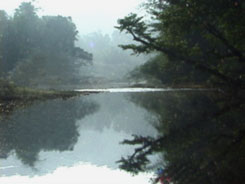
![]() In
the Treta-yuga, Lord Parasurama came to this place and bathed in the River
Dhara in order to absolve himself of the sins of exterminating the ksatriya-race
twenty one times over.
In
the Treta-yuga, Lord Parasurama came to this place and bathed in the River
Dhara in order to absolve himself of the sins of exterminating the ksatriya-race
twenty one times over.
In Dvapara-yuga, when Samba, the son of Sri Krsna was cursed with leprosy, he came to bathe in the Dhara in order to become free from the disease. By smearing the mud from the riverbank over his body and bathing in the river, he regained his orignal beauty. From that time on, the waters of the Dhara River have become famous for curing skin diseases. During this age the Pandavas also visited this holy place.
In more recent times Subrahmanya was visited by Adi Sankaracarya who referred to this place as ‘Bhaje Kukke Lingam’ in his composition Subrahmanya Bhujangaprayata Stotram.
The Abode of the Snake-King
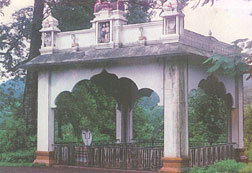
![]() Previous
to Karttikeya, the snake-king Vasuki took up residence in Subrahmanya.
According to the Skanda Purana, Garuda was once hunting for snakes
to devour and came across Vasuki hiding in a large cave (this cave is
called ‘Biladvara’ and is close to the temple). Striking Vasuki
with his mighty wings and tearing at him with his sharp claws and beak,
Garuda tried to kill him. Owing to Vasuki’s strength however, Garuda
became dazed by the poisonous vapors emitting from Vasuki’s mouth,
as well as the luminous jewels on his hood.
Previous
to Karttikeya, the snake-king Vasuki took up residence in Subrahmanya.
According to the Skanda Purana, Garuda was once hunting for snakes
to devour and came across Vasuki hiding in a large cave (this cave is
called ‘Biladvara’ and is close to the temple). Striking Vasuki
with his mighty wings and tearing at him with his sharp claws and beak,
Garuda tried to kill him. Owing to Vasuki’s strength however, Garuda
became dazed by the poisonous vapors emitting from Vasuki’s mouth,
as well as the luminous jewels on his hood.
As they fought, the great sage Kasyapa Muni appeared and requested Garuda to desist from killing Vasuki who was a great devotee of Lord Siva.

![]() With
great humility, Garuda folded his palms and told the sage that he was
starving and had not eaten in days. Kasyapa told him, "Go to the Ramanaka
Islands (modern day Fiji) where snakes and uncivilized Kiratas (hunters)
are available in plenty." Immediately Garuda went to that place to satisfy
his hunger.
With
great humility, Garuda folded his palms and told the sage that he was
starving and had not eaten in days. Kasyapa told him, "Go to the Ramanaka
Islands (modern day Fiji) where snakes and uncivilized Kiratas (hunters)
are available in plenty." Immediately Garuda went to that place to satisfy
his hunger.
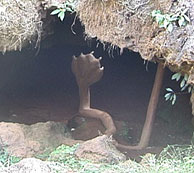 Turning
to Vasuki, Kasyapa Muni said, "O best of serpents, go to Kumara Ksetra
in the Sahyadri Mountains and pray to Lord Siva. You will never be bothered
by Garuda again." Bowing to the sage, Vasuki and his family went to Subrahmanya
Ksetra and attained the blessings of Siva who told him, "In the next kalpa,
my son Karttikeya will come and reside here. He will bless you and you
will always remain by his side." Later, after Karttikeya killed Tarakasura
and married Indra’s daughter Devasena, Vasuki was united with him
and has been worshipped alongside Karttikeya ever since.
Turning
to Vasuki, Kasyapa Muni said, "O best of serpents, go to Kumara Ksetra
in the Sahyadri Mountains and pray to Lord Siva. You will never be bothered
by Garuda again." Bowing to the sage, Vasuki and his family went to Subrahmanya
Ksetra and attained the blessings of Siva who told him, "In the next kalpa,
my son Karttikeya will come and reside here. He will bless you and you
will always remain by his side." Later, after Karttikeya killed Tarakasura
and married Indra’s daughter Devasena, Vasuki was united with him
and has been worshipped alongside Karttikeya ever since.
The Deity of Sri Karttikeya
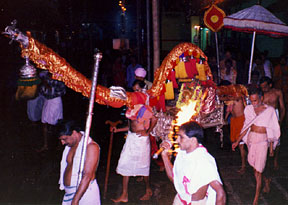 Skanda
Purana narrates how, after Karttikeya had slain Tarakasura, Lord Brahma
installed the deity of Karttikeya in Subrahmanya Ksetra along with the
deity of Vasuki through whom Karttikeya accepts the worship of his devotees.
The deity is popularly known as ‘Sri Subrahmanya Svami’. In
front of the altar is a sliver garuda-stambha which is said to
have been erected and consecrated with special mantras in order
to shield the devotees from the poisonous vapors from Vasuki’s mouth
within the garbha-grha (altar-room).
Skanda
Purana narrates how, after Karttikeya had slain Tarakasura, Lord Brahma
installed the deity of Karttikeya in Subrahmanya Ksetra along with the
deity of Vasuki through whom Karttikeya accepts the worship of his devotees.
The deity is popularly known as ‘Sri Subrahmanya Svami’. In
front of the altar is a sliver garuda-stambha which is said to
have been erected and consecrated with special mantras in order
to shield the devotees from the poisonous vapors from Vasuki’s mouth
within the garbha-grha (altar-room).
Different utsavas (festivals) are held for the Deity according to the season. Some months he is taken on a ratha (chariot), other times he is taken on a palki (palanquin) accompanied by traditional music and colourful banners.

![]()
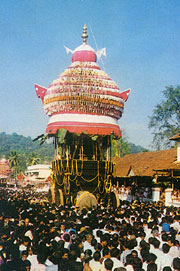 The
biggest festival held here is on Campa-sasti during the month of Margasirsa
(Nov/Dec) when the deity is taken out on the huge brahma-ratha.
The
biggest festival held here is on Campa-sasti during the month of Margasirsa
(Nov/Dec) when the deity is taken out on the huge brahma-ratha.
On the same side as the shrine of Bhairava are the ancient deities of the mother-goddess Hosaligamma and Purusa-raya. They are considered to be the bodyguards of Subrahmanya.
On the north-east side of the temple compound are the deities of Uma-Mahesvara which were installed by Sri Narada Muni.
Samputa
Narasingha Matha
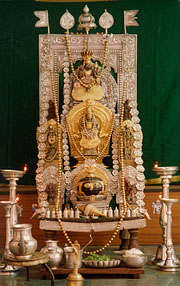
![]() For
Vaisnavas, Subrahmanya Ksetra also has some significance. On the south-eastern
side of the temple of Karttikeya is the shrine of Samputa Narasingha established
by Srila Madhvacarya.When Madhva visited the Himalayan tirtha of
Badarinatha, he was presented eight salagrama-silas by Srila Vyasadeva
known as the ‘Vyasa-musti’. Six of these salagramas
are presently being worshipped in this temple, while the other two are
in Sode Matha and Uttaradi Matha (although there is some controversy
whether the eighth is in the Uttaradi Matha, Vyasaraya Matha
or the Raghavendra Matha).
For
Vaisnavas, Subrahmanya Ksetra also has some significance. On the south-eastern
side of the temple of Karttikeya is the shrine of Samputa Narasingha established
by Srila Madhvacarya.When Madhva visited the Himalayan tirtha of
Badarinatha, he was presented eight salagrama-silas by Srila Vyasadeva
known as the ‘Vyasa-musti’. Six of these salagramas
are presently being worshipped in this temple, while the other two are
in Sode Matha and Uttaradi Matha (although there is some controversy
whether the eighth is in the Uttaradi Matha, Vyasaraya Matha
or the Raghavendra Matha).
Along with the eight Vyasa-musti, Srila Vyasadeva also gave Madhva a Narasingha salagrama that is said to be so powerful that if it is uncovered, the three worlds would be engulfed in the flames emanating from Lord Narasingha.
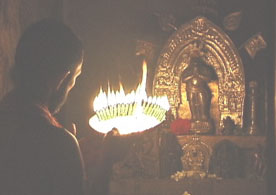 Consequently
Sri Madhva Muni placed the salagrama within the safe confines of
a box (samputa) along with 22 Laksmi-Narayana silas and
five of the vyasa-musti silas (the sixth is worshipped outside
the box). This Deity of Samputa Narasingha was so dear to Madhvacarya
that Sri Vadiraja Svami, in his Tirtha Prabandha, has referred
to Him as ‘The heart of Madhva’.
Consequently
Sri Madhva Muni placed the salagrama within the safe confines of
a box (samputa) along with 22 Laksmi-Narayana silas and
five of the vyasa-musti silas (the sixth is worshipped outside
the box). This Deity of Samputa Narasingha was so dear to Madhvacarya
that Sri Vadiraja Svami, in his Tirtha Prabandha, has referred
to Him as ‘The heart of Madhva’.
Although this Narasingha salagrama is worshipped daily, it is never removed from the box except for bathing, and only then by the sannyasi who is the mathadipati (head of the Subrahmanya Matha). Nobody else is allowed to see this Deity. If the head of the matha becomes sick and is incapacitated, the right of seva goes to the svami of Sri Pejavara Adhoksaja Matha in Udupi. The present mathadhipathi of Subrahmanya Matha is H.H.Sri Vidyaprasanna Tirtha Svamiji.
Vidyaprasanna Tirtha Svami
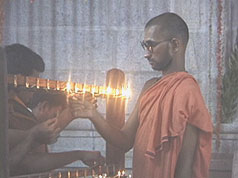
![]() Sri
Madhvacarya established the matha in Subrahmanya and made his brother
Sri Visnu Tirtha the first mathadhipati. Sri Visnu Tirtha is said
to still reside in the Kumara Mountains nearby where he is performing
austerities at the place known as ‘Siddha Parvata’. He returns
to the matha sometimes to perform puja to Samputa Narasingha.
Many devotees have heard the sound of bells inside the garbha-grha
late at night when the temple is locked. It is said that when the Dvaita
tradition is almost dead, Sri Visnu Tirtha will return to re-establish
it.
Sri
Madhvacarya established the matha in Subrahmanya and made his brother
Sri Visnu Tirtha the first mathadhipati. Sri Visnu Tirtha is said
to still reside in the Kumara Mountains nearby where he is performing
austerities at the place known as ‘Siddha Parvata’. He returns
to the matha sometimes to perform puja to Samputa Narasingha.
Many devotees have heard the sound of bells inside the garbha-grha
late at night when the temple is locked. It is said that when the Dvaita
tradition is almost dead, Sri Visnu Tirtha will return to re-establish
it.
Samputa Narasingha
 During the time of
Sri Aniruddha Tirtha (a direct disciple of Sri Madhva and the second pontiff
of the matha), King Ballalaraya of the Hoysala Dynasty stole the
box containing the Narasingha salagrama. Desiring to see the Deity,
he hired four blacksmiths to forcibly open the box. Unfortuately, when
they tried, they all died on the spot. The king also tried to open the
box by having an elephant stand on it –the result was that the elephant
also died immediately. Because of his great offence, King Ballalaraya
felt a great burning sensation within his body, and it was only when he
returned Samputa Narasingha to Sri Aniruddha Tirtha and obtained his blessings
that he was relieved from his malady. In the compound of the Subrahmanya
temple there is a statue of Ballalaraya which commemorates this incident.
Pilgrims offer him cotton, mustard, butter and pumpkin to cool his body
down.
During the time of
Sri Aniruddha Tirtha (a direct disciple of Sri Madhva and the second pontiff
of the matha), King Ballalaraya of the Hoysala Dynasty stole the
box containing the Narasingha salagrama. Desiring to see the Deity,
he hired four blacksmiths to forcibly open the box. Unfortuately, when
they tried, they all died on the spot. The king also tried to open the
box by having an elephant stand on it –the result was that the elephant
also died immediately. Because of his great offence, King Ballalaraya
felt a great burning sensation within his body, and it was only when he
returned Samputa Narasingha to Sri Aniruddha Tirtha and obtained his blessings
that he was relieved from his malady. In the compound of the Subrahmanya
temple there is a statue of Ballalaraya which commemorates this incident.
Pilgrims offer him cotton, mustard, butter and pumpkin to cool his body
down.
Along with the salagamas, there are a number of Deities which belonged to previous acaryas of the matha including a Laksmi-Nrsingha Deity and Deities of Vittala (Krsna), Rukmini and Satyabhama which were also worshipped by Madhvacarya.
Vrndavanas and
Somanathesvara Temple
About a mile away, on the banks of the Kumaradhara
River, is the village of Agrahara where thirty vrndavanas (samadhis)
of many of the previous mathadipatis of the Subrahmanya Matha are
situated. The most famous vrndavanas found
here are that of Sri Aniruddha Tirtha and Sri Varaha Tirtha.
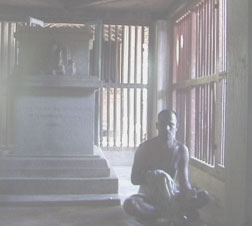 On
the 5th day of the month of Margasirsa (Nov/Dec), Sri Varaha
Tirtha Svamiji passed away. It is the custom for the present mathadipati
to take his bath at this place on that day and worship the vrndavana
of Varaha Tirtha Svami. Therefore, the bathing-ghata at this place
is known as Pancami Tirtha (pancami being the fifth day of
the month).
On
the 5th day of the month of Margasirsa (Nov/Dec), Sri Varaha
Tirtha Svamiji passed away. It is the custom for the present mathadipati
to take his bath at this place on that day and worship the vrndavana
of Varaha Tirtha Svami. Therefore, the bathing-ghata at this place
is known as Pancami Tirtha (pancami being the fifth day of
the month).
Near to the vrndavanas is a temple of Lord Siva known as the Somanathesvara Temple where the siva-lingam is said to have been installed over 1000 years ago. Centuries before, there was a thriving brahmana community here to serve the deity, but for some unknown reason, the population thinned out, the temple became dilapidated, and the seva to the deity ended. Recently however, the temple has come under the able management of the Subrahmanya Matha and has been renovated. Madhva brahmanas affiliated to the Subrahmanya Matha now take care of the Deity of Sri Somanathesvara.